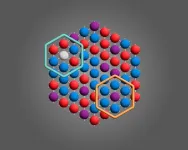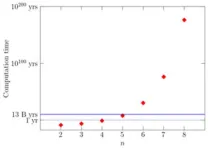The research, led by Murdoch Children’s Research Institute (MCRI) in Melbourne and published in Allergy, found two thirds of children with a peanut allergy remain allergic by the age of 10. But for those who did naturally outgrow their allergy, the majority achieved this by six years old.
The study was the first to use antibodies as biomarkers to identify persistent or a resolved peanut allergy during the first 10 years of life in children who naturally outgrew their allergy without clinical intervention.
A rise or drop in the levels of two antibodies (sIgG4 and sIgE) that respond to peanut allergens were key to determining allergy resolution. Changes in the blood test levels of these two antibodies were detected in children who naturally outgrew their allergy.
Antibody levels measured at diagnosis did not predict who would outgrow their peanut allergy, but changes in these levels over time revealed who was more likely to.
The study involved 156 infants in Melbourne with challenge-confirmed peanut allergy from the HealthNuts study who were followed up at ages four, six and 10 years with questionnaires, skin prick tests, blood tests and oral food challenges.
Peanut allergy resolved in a third of children by 10 years, with nearly all who outgrew the allergy doing so by age four to six.
MCRI researcher Kayla Parker said the findings would help clinicians better identify which children were likely to have an ongoing peanut allergy and ensure they received ongoing education and management.
“Little was known before this research about whether antibodies could be used as biomarkers of naturally resolving peanut allergy during the primary school years,” she said.
“We found the longitudinal changes were more useful in predicting those children on the path to peanut allergy resolution than relying on a single snapshot at one timepoint.”
Ms Parker said regular review of children with a peanut allergy by their allergist was important to ensure they receive the most appropriate clinical care.
“Children allergic to peanut who have decreasing antibody markers may benefit from additional visits with their allergist to determine the right time for follow-up food challenges to confirm if their peanut allergy has resolved,” she said.
“Those with high or increasing levels of these biomarkers are less likely to spontaneously outgrow their peanut allergy and could be prioritised for potential early treatment options if available.
“Currently there is no routinely available treatment for peanut allergy and children should maintain strict peanut allergen avoidance, however innovative treatment options are available through food allergy clinical trials, which are listed on the National Allergy Centre of Excellence’s Allergy Studies Directory.”
It comes as another new study, led by MCRI, found allergic diseases continue to be a significant public health burden in Australian children, with allergies affecting 40 per cent of primary school-aged children and a third having multiple allergies.
Published in The Journal of Allergy and Clinical Immunology: In Practice, the research reported 45 per cent of infants with a food allergy have persistent symptoms to age 10.
Between the ages of six and 10, asthma prevalence remained similar at around 13 per cent, eczema rates decreased from 15 per cent to 13 per cent while hay fever cases increased from 15 per cent to 25 per cent.
MCRI Associate Professor Rachel Peters said the research highlighted the importance of prevention and treatment strategies, particularly for nut allergies, as well as eczema, asthma and hay fever.
“Understanding how allergy prevalence varies across the school years has important implications on informing the burden of disease, allocating healthcare resources and improving school and workforce planning,” she said.
Melbourne mum Vivienne Lai’s daughter, Emilia, 3, has multiple food allergies (cow’s milk, peanut, eggs, cashews and pistachios).
Emilia was first diagnosed with a cow’s milk allergy at 10 months after having an allergic reaction to yogurt.
“She initially was able to tolerate these foods, so it was a huge shock when the allergy test came back positive for so many different allergens,” Vivienne said.
“We try our best to avoid the allergens in places like restaurants and daycare and follow an allergy action plan, but Emilia still has reactions from time to time.”
In her first six months back at work after having Emilia, who was then aged one, Vivienne said she received frequent calls from the daycare centre.
“It was anxiety-inducing for us and the staff who were trying to work out what was trigging the allergic reactions,” she said. We always worry because even if the food label or menu says no traces of a certain food it’s not always accurate.”
Emilia’s most severe allergic reaction came after eating what was thought to be dairy free jelly, the day after her third birthday party.
“We were eating the birthday party leftovers the next day when Emilia started to cough uncontrollably and break out in hives after eating jelly,” Vivienne said.
“We gave her antihistamines, but it only brought the swelling down in her face briefly. Panic started to set in, so we decided to use the EpiPen for the first time and called an ambulance.”
Emilia was treated at hospital and discharged four hours later.
Vivienne said given how life-threatening allergies could be, the latest MCRI around which children were likely to outgrow their peanut allergy was a significant development.
“The finding gives families like ours some certainty to the future,” she said. Even if a blood test showed Emilia wasn’t to outgrow her peanut allergy at least it gives us a plan forward, knowing this is going to be a lifelong challenge and we will need to manage her diet closely.”
Associate Professor Peters and Ms Parker are also members of the National Allergy Centre of Excellence (NACE) and the Centre for Food Allergy Research (CFAR), both based at MCRI to help accelerate allergic disease research across Australia.
Researchers from the University of Melbourne, The Royal Children’s Hospital, Monash Children’s Hospital and the University of Queensland also contributed to the findings.
Publication 1: Kayla M. Parker, Thanh D. Dang, Rushani Wijesuriya, Victoria X. Soriano, Adrian J. Lowe, Shyamali C. Dharmage, Paxton Loke, Mimi L. K. Tang, Katie J. Allen, Jennifer J. Koplin, Kirsten P. Perrett and Rachel L. Peters. ‘Longitudinal peanut and Ara h 2 specific-IgE, -IgG4 and -IgG4/-IgE ratios are associated with the natural resolution of peanut allergy in childhood,’ Allergy. DOI: 10.1111/all.16111
Publication 2: Rachel L Peters, Victoria X Soriano, Katrina J Allen, Mimi L. K. Tang, Kirsten P Perrett, Adrian J Lowe, Rushani Wijesuriya, Kayla M Parker, Paxton Loke, Shyamali C Dharmage and Jennifer J Koplin. ‘The prevalence of IgE-mediated food allergy 1 and other allergic diseases in the first 10 years 2 of life: The population-based, longitudinal HealthNuts study. The Journal of Allergy and Clinical Immunology: In Practice. DOI: 10.1016/j.jaip.2024.03.015
*The content of this communication is the sole responsibility of MCRI and does not reflect the views of the NHMRC.
Available for interview:
Associate Professor Rachel Peters, MCRI Team Leader, Population Allergy
Kayla Parker, MCRI allergy researcher
Vivienne Lai, whose daughter Emilia, 3, has multiple food allergies
END



